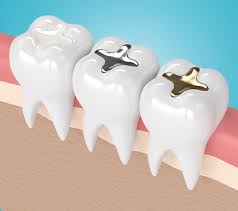
Tooth-colored or composite fillings have revolutionized dental care by offering a blend of aesthetics and functionality. Unlike traditional metal fillings, which are noticeable due to their silver color, composite fillings are designed to match the natural shade of your teeth, providing a seamless restoration. Let’s delve into composite resin materials and why they have become popular in modern dentistry, especially for those seeking the best tooth filling in Ghatkopar.
Composition of Composite Resin Materials
Composite resin fillings are made from different materials, each chosen for its specific properties and role in creating a durable and aesthetically pleasing dental restoration. Here are the key components typically found in composite resin:
- Resin Matrix: The base of composite resin fillings is a polymerizable resin matrix. This resin usually comprises bisphenol-A-glycidyl methacrylate (Bis-GMA) or a similar material. The resin matrix provides the filler particles with a medium to be suspended in and contributes to the overall strength and durability of the filling.
- Filler Particles: To enhance the composite material’s mechanical and aesthetic properties, filler particles are added to the resin matrix. These particles are typically made of inorganic materials such as silica or glass ceramics. The size and shape of these filler particles influence the composite material’s strength, wear resistance, and optical properties.
- Coupling Agent: A coupling agent enhances the bond between the resin matrix and the filler particles. This improves the composite material’s overall strength and stability by ensuring the effective integration of the components.
- Pigments and Opacifiers: Pigments and opacifiers are added to the composite resin to achieve the desired shade and opacity that matches the natural color of your teeth. These additives allow the dentist to customize the color of the filling to blend seamlessly with your natural tooth structure.
- Initiators and Accelerators: Initiators and accelerators are chemical compounds that facilitate the resin matrix’s polymerization (hardening) process when exposed to a curing light. This curing process is crucial for transforming the pliable composite material into a durable, solid filling that bonds securely to the tooth.
Advantages of Composite Resin Fillings
- Aesthetic Appeal: Composite resin fillings can be shade-matched to blend invisibly with your natural teeth, making them ideal for visible areas of the mouth.
- Conservation of Tooth Structure: Compared to metal fillings, composite resin fillings require minimal removal of healthy tooth structure, preserving more of the natural tooth.
- Versatility: Composite resin can be used to fill cavities and repair chipped, broken, or worn teeth. It can also be used for cosmetic purposes, such as reshaping or changing the color of teeth.
- Reduced Sensitivity: Composite materials transmit less temperature sensitivity (hot and cold) than metal fillings, reducing the risk of post-treatment discomfort.
- Durable: Modern composite materials are durable and can withstand the normal forces of chewing when properly cared for, providing long-term functionality.
The Process of Placing Composite Resin Fillings
The procedure for placing composite resin fillings involves several steps:
- Preparation: The dentist numbs the area around the affected tooth and removes any decayed or damaged tooth structure.
- Application: The composite resin material is applied in layers, with each layer carefully shaped to match the natural contours of the tooth.
- Curing: A special curing light hardens each layer of the composite material. This process bonds the filling securely to the tooth structure.
- Shaping and Polishing: Once the composite material is hardened, the dentist trims and shapes the filling to fit the bite comfortably. The filling is then polished to blend seamlessly with the tooth’s natural surface.
Conclusion
Composite resin fillings significantly advance dental materials, offering both aesthetic benefits and functional durability. By understanding the composition and properties of composite resin materials, patients can appreciate why tooth-colored fillings have become a preferred choice for restoring teeth affected by decay or damage. If you’re considering dental fillings or have questions about composite resin materials, consult your dentist to explore how these modern restorations can enhance your smile and improve your oral health. For those in Ghatkopar, finding the best tooth filling involves looking for a dentist who specializes in composite resin to ensure optimal results.







